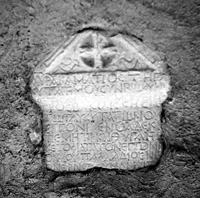 MAMA XI 361 (Kana)
MAMA XI 361 (Kana) 
Funerary stele of Kyria, Basilissa and Palladios
- Type of monument:
- Funerary stele.
- Location:
- Gene Yaylası (Beşağıl) (Kana): in the wall of a house.
- Description:
- White marble stele with vaulted pediment, broken below. In the pediment, cross in circle, with incised birds to left and right.
- Dimensions:
- Ht. 0.37+; W. 0.35; Th. --; letters 0.020-0.025.
- Record:
- WMC notebook copy; photograph (1954/51).
- Publication:
- None.
- Date:
- Third or fourth century AD.
Αὐρ(ήλιος) Ἀκαμάτιος τῇ γλ[υ]-
κυτάτῃ μου συνβίῳ Κυρίῃ̣
κὲ τῆς φιλτάτης μου θυγ[α]-
τρὸς Βασιλίσσης κὲ
5τῷ γλυκυτάτῳ μου
ἐγγόνι. v. ἐνθάδε κῖ-
τε μήτηρ καὶ θυγάτηρ
κὲ τὸ φίλτατον ἐγγόνι-
όν μου Παλλάδιος νέ-
10ον ἔρνος̣ συναμφιπ-
[ολεύσας (?) - - - - -]
Aur(elius) Akama(n)tios, for my sweetest wife Kyria and my dearest daughter Basilissa and my sweetest grandchild. Here lie mother and daughter and my dearest grandchild Palladios, the new shoot, who served as joint priest/attendant (?)...




The name Ἀκαμά(ν)τιος is exceptionally rare. To the best of my knowledge, it only appears elsewhere at Dorylaion in Phrygia, where it is found as the signum or honorific nickname of Q. Voconius Aelius Stratonikos, honoured as a ‘New Akamas’ or second founder of Dorylaion (Merkelbach and Stauber 2001: 16/34/06, 07, 09; Robert, OMS VI, 450-2). Akamas, son of Theseus, was considered to be one of the mythological founders of several cities in Phrygia (Dorylaion, Synnada, Metropolis: Robert, OMS IV, 90-1; VI, 451-2). For the name Basilissa in this region, see also MAMA XI 287 (1956/130: Zengicek [Koçyaka]); MAMA XI 211 (1954/75: Azak [Hodoğlu]).
The phrase νέον ἔρνος may be a Homeric echo (H., Od. 6.163: φοίνικος νέον ἔρνος ἀνερχόμενον ἐνόησα); it appears in another Christian funerary inscription from this region (MAMA XI 303: Karakaya, on the eastern edge of the Konya plain), Πέτρῳ πινυτῇ ἀνεψιῷ νέῳ ἔρνι. The poetic term ἔρνος was relatively common in the Christian funerary epigraphy of Lykaonia and the Axylon; compare MAMA VII 559 (Kuyulusebil); MAMA VII 587 (Kolukısa, ancient *Keissia), ἐξ ἀγαθῆς ῥίζης ἔρνος κλυτὸν ἐξεφαάνθη; CIG 3989m (Merkelbach and Stauber 2001: 14/06/18, Kadınhanı), νέος ἡλικείην, ἔρνος κλυτὸν, ἐνθάδε κῖτε. I can see no other way of restoring the final line than with a participle συναμφιπ[ολεύσας] vel sim.; the verb is attested at Apollonia in Illyria in the fourth or third century BC (BE 2008, 283), but I can find no parallels for its use in a Christian context.